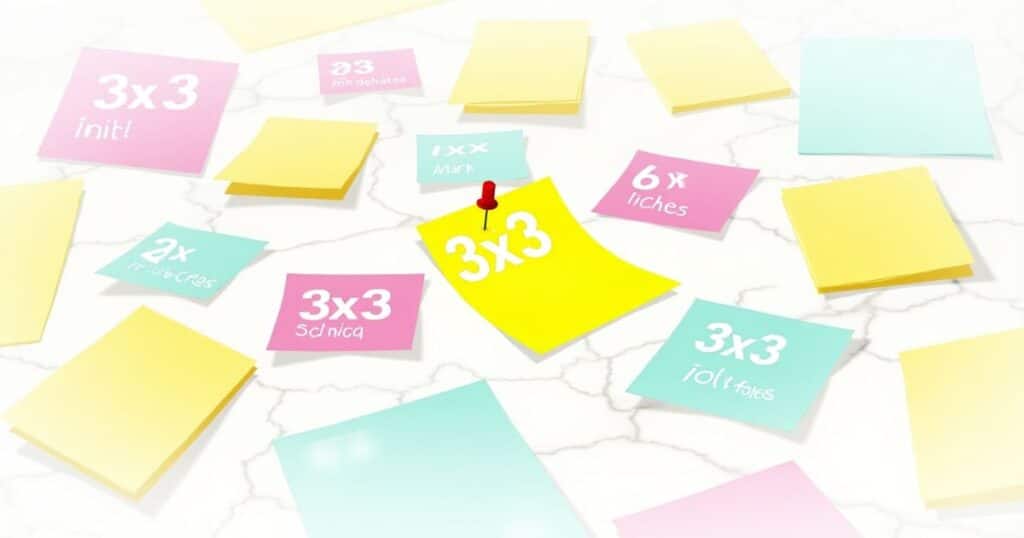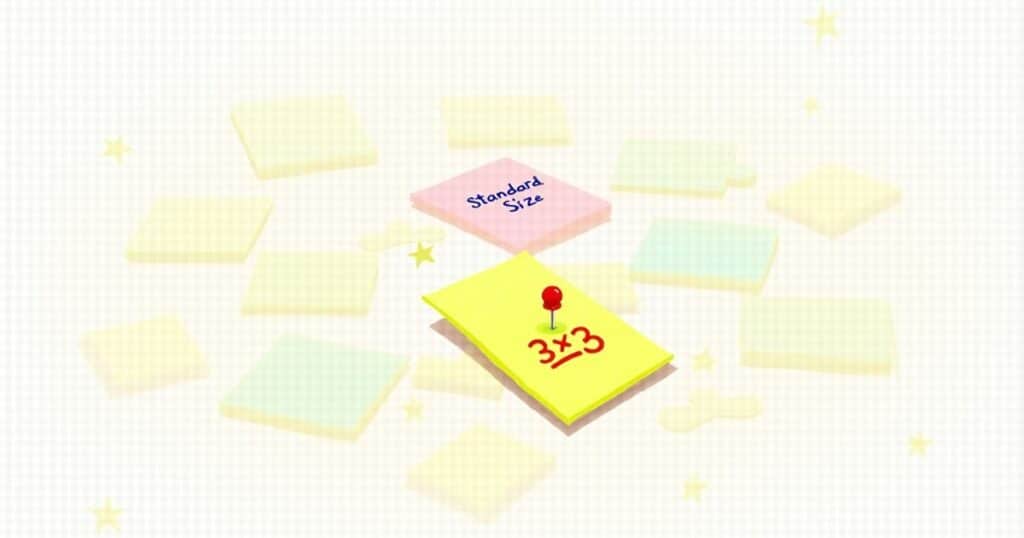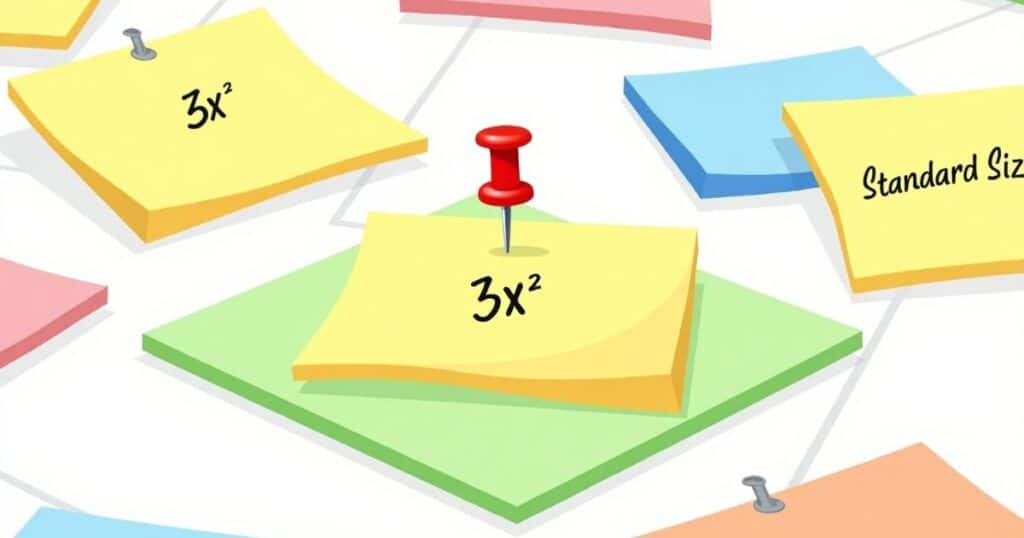Have you ever grabbed a sticky note to jot down a quick thought, only to pause and wonder why this little paper square feels so perfectly sized for its purpose? Those vibrant, adhesive paper notes we stick everywhere from computer monitors to refrigerators weren’t created by accident.
The standard sticky note’s dimensions were carefully designed to balance visibility, convenience, and utility.
These humble paper helpers have revolutionized how we remember things, organize thoughts, and communicate quick messages in both our professional and personal lives.
In a world increasingly dominated by digital notifications, there’s something wonderfully tangible about a sticky note its physical presence demanding attention in a way that digital reminders often fail to achieve.
Whether you’re a meticulous planner who color-codes notes by project or someone who hastily scribbles reminders, understanding the dimensions of these versatile tools can help you use them more effectively.
How Big is a Standard Sticky Note?
A standard sticky note measures 3×3 inches (76×76 mm), creating a perfect square that’s large enough to capture a thought but small enough to place almost anywhere.
This isn’t random this size fits comfortably in your hand, provides enough space for a short message or reminder, and doesn’t overwhelm documents or surfaces where it’s placed.
You can visualize this size by thinking about a deck of cards a standard sticky note is just slightly smaller than a playing card, making it instantly recognizable and practical for everyday use.
The Evolution of Sticky Note Dimensions
The Original 3×3 Post-it® Note
Back in 1974, when 3M scientist Spencer Silver accidentally created a “low-tack” adhesive that would stick to surfaces but could be easily removed without leaving residue, he didn’t immediately know what to do with his discovery.
It wasn’t until his colleague Art Fry, frustrated by paper bookmarks falling out of his hymnal during choir practice, realized they needed a bookmark that would stick but not damage pages.
The 3×3 inch dimension was chosen after careful testing large enough to write a meaningful note, small enough to be unobtrusive.
“We didn’t want to overwhelm the document,” Art Fry later explained in interviews. “The note needed to flag attention without hiding what was underneath.”
This carefully calculated size became an instant hit when Post-it® Notes launched nationally in 1980.
The bright canary yellow color was chosen not for aesthetic reasons but because it was the only scrap paper available in the lab during development yet another happy accident that became iconic.
The adhesive strip, typically placed along one edge covering about 1/2 inch of the note, leaves approximately 8.5 square inches of writable space on a standard note. This proportion has proven ideal for the average message length most people write on sticky notes.

Expanding the Family: Various Sticky Note Sizes
As sticky notes grew in popularity, manufacturers introduced various sizes to meet different needs:
Mini Sticky Notes (1.5×2 inches)
These tiny notes are perfect for very brief reminders or marking pages. They’re ideal when you need to flag something without drawing too much attention. Many people use these smaller notes for marking recipes in cookbooks or important passages in textbooks.
The mini note saves desk space while still being large enough to write brief phrases like “Sign this” or “Call back.” Their small footprint makes them perfect for personal planners and calendars where space is at a premium.
The Legal Pad Style (3×5 inches)
Slightly larger than the standard size, these rectangular notes provide more writing space while maintaining the convenience of the adhesive strip. They’re particularly useful for more detailed instructions or when you need to list multiple items.
These notes mimic the dimensions of index cards, giving you enough room for about 5-7 lines of handwritten text. They’re commonly found in office settings where more detailed notes might be needed.
The Jumbo Note (4×4 or 4×6 inches)
When you need to make a statement or leave detailed instructions, jumbo sticky notes command attention. These larger formats provide enough space for diagrams, multiple paragraphs, or notes that will be shared among several people.
Many teachers and presenters use these larger notes during brainstorming sessions or for posting important notices that need to be visible from a distance.
See Also: Staple Sizes – Sizes of Common Objects and Stuff
The Science Behind Sticky Note Dimensions
The standard sticky note’s dimensions weren’t arbitrarily chosen they reflect an understanding of human psychology and ergonomics:
Visibility Threshold
Research in visual perception suggests there’s a minimum size threshold for objects to capture attention without conscious effort. The 3×3 inch dimension hits this sweet spot large enough to notice peripherally but not so large as to be distracting.
Studies in workplace environments show that notes smaller than 2×2 inches often get overlooked, while notes larger than 4×4 inches can feel imposing and create visual clutter. The standard size strikes the perfect balance.
Writing Space Psychology
The average adult handwriting requires about 0.25-0.3 inches of vertical space per line. A 3×3 inch note comfortably accommodates 5-6 lines of handwritten text enough for a complete thought or reminder without encouraging excessive verbosity.
Psychologists note that this constraint actually improves communication. “The limited space forces conciseness,” explains Dr. Melanie Thompson, a cognitive psychologist specializing in written communication.
“People naturally prioritize the most important information when space is limited, often resulting in clearer communication.”
Adhesive-to-Paper Ratio
The engineering behind sticky notes includes careful consideration of the adhesive strip proportion.
Too little adhesive and the note falls off; too much and it might damage surfaces or be difficult to remove.
The standard design allocates approximately 15-20% of the note’s surface to the adhesive strip.
This balance ensures the note stays put under normal conditions while remaining easy to reposition when needed.

Practical Applications of Different Sticky Note Sizes
Office Communication
In office settings, different sticky note sizes serve distinct purposes:
- Standard 3×3 notes work well for brief reminders on computer monitors, file folders, or desk edges
- Larger 4×6 notes are ideal for leaving more detailed instructions or feedback on documents
- Flag-style tiny notes help mark specific paragraphs or sections in reports without obscuring text
Many offices develop informal sticky note “codes” where different sizes or colors represent different types of messages or urgency levels.
Personal Organization
For personal use, sticky notes help externalize our memory:
- Mini notes work well as bookmark tags or to mark calendar dates
- Standard notes are perfect for shopping lists or daily to-dos
- Larger notes can hold weekly meal plans or project steps
Research in productivity suggests that physically writing and posting notes in visible locations significantly increases task completion rates compared to digital reminders alone.
Creative and Educational Uses
Beyond basic reminders, sticky notes have found their way into creative and educational methods:
- Writers use them for storyboarding and organizing plot points
- Software developers employ them in Agile methodology for tracking project features
- Educators use them for interactive classroom activities and visual learning exercises
- Therapists and counselors utilize sticky note exercises for emotional processing and goal setting
The physical nature of sticky notes being able to move, cluster, and rearrange them makes them valuable tools for visual thinkers and collaborative processes.
Environmental Considerations of Sticky Notes
While sticky notes are undeniably useful, their environmental impact deserves consideration:
Material Usage
A standard 3×3 sticky note uses approximately 0.07 square feet of paper. An average office worker might use 5-10 notes daily, amounting to around 1,800 notes annually. Multiply that across a large organization, and the paper usage becomes significant.
Many manufacturers now offer recycled paper options and have reduced the paper weight without compromising functionality. The original Post-it® Notes used 73 gsm (grams per square meter) paper, but many modern versions use lighter 60-65 gsm paper, reducing material consumption.
Recyclability Challenges
The adhesive strip on sticky notes can complicate recycling processes. While technically recyclable, the adhesive can create issues in paper recycling equipment if present in large quantities.
To address this, some manufacturers have developed more environmentally friendly adhesives that break down more easily during recycling.
Users concerned about sustainability can also cut off adhesive strips before recycling or switch to reusable alternatives like whiteboards for temporary notes.
See Also: Thank You Card Sizes (Standard & Other Sizes)
Digital Alternatives to Physical Sticky Notes
As our world becomes increasingly digital, virtual sticky note applications have emerged:
Digital Sticky Note Features
Digital sticky notes offer several advantages:
- They never run out or fall off
- They can be searched, categorized, and synced across devices
- They often include features like reminders and sharing options
- They eliminate paper waste
However, research suggests they don’t always carry the same psychological impact as physical notes. A 2018 study in the Journal of Applied Cognitive Psychology found that physically writing and posting notes resulted in 33% better information recall than typing the same information into digital note apps.
Finding the Right Balance
Many productivity experts recommend a hybrid approach:
- Use physical sticky notes for immediate, high-visibility reminders
- Employ digital solutions for long-term storage and organization
- Consider your personal cognitive style some people respond better to physical cues while others prefer digital systems
The key is being intentional about which medium best serves each specific purpose rather than defaulting to one or the other exclusively.
DIY Custom Sticky Notes
For those with specific needs, creating custom-sized sticky notes is surprisingly simple:
Making Your Own Sticky Notes
With liquid adhesive products specifically designed for creating repositionable notes, you can:
- Cut any paper to your preferred dimensions
- Apply a thin strip of removable adhesive along one edge
- Create custom shapes, sizes, or use specialty papers
This approach is particularly useful for specialized applications like architectural plans, craft projects, or when working with non-standard document sizes.
Conclusion
The standard 3×3 inch sticky note has endured for over four decades not by accident but because its dimensions perfectly serve its purpose.
Large enough to capture a complete thought, small enough to place anywhere without becoming obtrusive, and proportioned to maximize utility while minimizing waste it’s a masterclass in thoughtful design.
Whether you’re a sticky note minimalist who uses them sparingly or someone whose monitor is framed with a rainbow of reminders, understanding the intentional design behind these humble paper squares can help you use them more effectively.
Next time you peel off a sticky note, take a moment to appreciate how its carefully calculated dimensions make it the perfect size for capturing your thoughts.
And maybe look around your home or office how many differently sized sticky notes can you find, and are you using each size to its best advantage?
Read more knowledgeable blogs on Measure Take.



